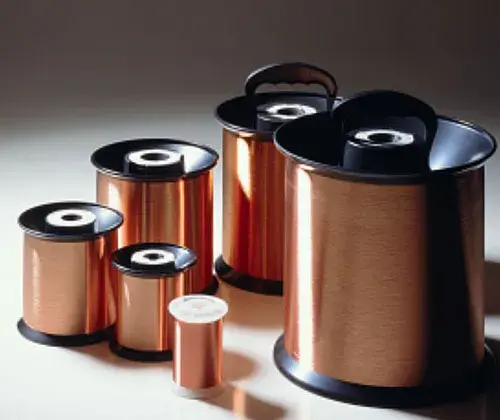
Magnet Wire and Insulation
Solderable Insulation
Solderable insulation is a special film insulation that is used on magnet wire in low cost, high volume applications.The magnet wire, with this solderable insulation,is wrapped around the terminal or pin.Then the terminal can be dip-soldered at the prescribed temperature without prior stripping.The ambient temperaturc range for this type of film insulation is 105C to 180C.
There are drawbacks in using some of the solderable insulation magnet wire.Prior to using, check your application with the wire manufacturer.Some solderable film insulation is not recommended where severe overloads may occur.Some solderable film insulations are susceptible to softening,due to prolonged exposure to strong solvents, such as alcohol, acetone, and methylethylketone.

Bondable Magnet Wire
Bondable magnet wires are a film-coated, copper or aluminum, with an additional coating of a thermoplastic adhesive. They are used in applications where it is desirable to have the bonding agent,such as a solvent, which will hold the coil form until it is oven-baked. Most adhesive coatings can be softened with solvents or heat. If a coil is wound with an irregular shape, held in a form, and then raised to the appropriate temperature, the coil will retain its shape. Bondable magnet wires have applications such as armatures, field coils, and self-supporting coils.
Base Film Insulation
All conventional film insulations may be adhesive-coated to achieve a bondable wire. However, care should be taken in selecting wires, which are insulated with high temperature films, since the adhesive coating may not withstand the equally high
temperatures. The temperatures, are for reference only. It
is wise to always check with the manufacturer for the latest in materials and application notes.The addition of the adhesive coating over the film insulation will result in an increase in the finished diameter, by the same magnitude, as if going from a single to a heavy insulation.
Bonding Methods
Heat Bonding may be accomplished by the use of a temperature-controlled oven. Small components can use a controlled hot air blower to bond the wires. In either case, caution should be used when handling the coil while it is still hot, since deformation can take place.
Resistance Bonding is a method where a current is passed through the winding to achieve the desired bonding temperature. This method generates a very even, heat
distribution resulting in a good bonding throughout the winding. Many coils can be resistance-bonded at the same time.The current required for one coil,will be the same current required when many are connected in series. Just solder the coils in series then adjust the applied voltage until the same current is reached.
Solvent Bonding is a method where the solvent activates the bonding material.This can be done,by passing the wire through a solvent-saturated felt pad or a light spray application.There are many activating solvents that can be used:denatured ethyl alcohol, isopropyl alcohol,methylethylketone and acetone.The solvents should always be checked on with the manufacturer for the latest in materials and application notes.
Miniature Square Magnet Wire
When product miniaturization calls for more copper in a given area, MWS Microsquare film, insulated magnet wire, allows the design of compact coils to deliver more power in less space. Microsquare magnet wire is available in both copper and aluminum. It is also available in a range of solderable and high temperature film insulation. A cross-section of a number 26, heavy build,micro square magnet wire.
